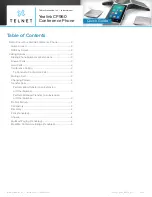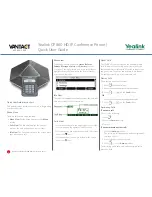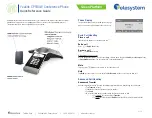
Phone Provisioning
74
MAC-Oriented CFG File
MAC-Oriented CFG file, which is named after the MAC address of the IP phone. For example, if the MAC address of
an IP phone is 00156574B150, the name of MAC-Oriented CFG file is 00156574b150.cfg (lowercase). It contains
parameters unique to a particular phone, such as account registration. It will only be effective for a MAC-specific IP
phone.
MAC-local CFG File
MAC-local CFG file, which is named after the MAC address of the IP phone. For example, if the MAC address of an
IP phone is 00156574B150, the name of the MAC-local CFG file is 00156574b150-local.cfg (lowercase). It contains
changes associated with a non-static parameter that you make via the web user interface or phone user interface
(for example, changes for time and date formats, ring tones, and DSS keys).
This file generates only if you enable the provisioning priority mechanism. It is stored locally on the IP phone and
you can upload it to the provisioning server each time the file updates. This file enables the users to keep their per-
sonalized configuration settings, even though the IP phone performs auto provisioning.
This file supports the overwrite mode. That is, you can clear the user's personalized configurations settings by delet-
ing a parameter or leaving the value of a parameter blank in the MAC-local CFG file on the server. Note that if there
is no MAC-local CFG file found on the server, the MAC-local CFG file on the phone will not be cleared.
Note
: The non-static changes that you made before enabling the provisioning priority mechanism are not saved in the gen-
erated MAC-local file, but the previous settings still take effect on the phone. The static changes are never be saved to the
<MAC>-local.cfg file.
The provisioning priority mechanism is enabled by the parameter “static.auto_provision.custom.protect”.
Configuration File Customization
You can create some new CFG files by making a copy and renaming the configuration template file (for example,
sip.cfg, account.cfg). You can rearrange the parameters in the configuration template file and create your own con-
figuration files with parameters you want. This flexibility is especially useful when you want to apply specific settings
to a group of phones.
Topic
Customizing a Configuration File
Customizing a Configuration File
1.
Copy and rename a configuration template file. For example, sip.cfg.
2.
Rearrange the parameters in the sip.cfg, and set the valid values for them.
For example:
phone_setting.contrast = 7
local_time.time_format = 1
account.1.anonymous_call = 1
account.2.dnd.enable = 1
features.dnd.enable = 0
3.
To specify parameters for specific phone models, add specific phone models in the front of the corresponding
parameters. Multiple phone model names are separated by commas.
For example:
[T46S,T48S]voice_mail.number.1 = *5
[T27G]account.1.dnd.enable = 1
[T46S]account.2.dnd.enable = 1
[T48S]features.dnd.enable = 0
## These parameters only apply to their own specific phone models.
4.
Save the configuration file and place it on the provisioning server.
Related Topic
Содержание CP920
Страница 1: ......
Страница 4: ...Before You Begin iii l Custom Logo Configuration l Supported Trusted Certificates ...
Страница 23: ...Table of Contents 19 ...
Страница 105: ...Administrator s Guide for SIP T2 T3 T4 T5 CP920 IP Phones 101 ...
















































